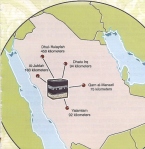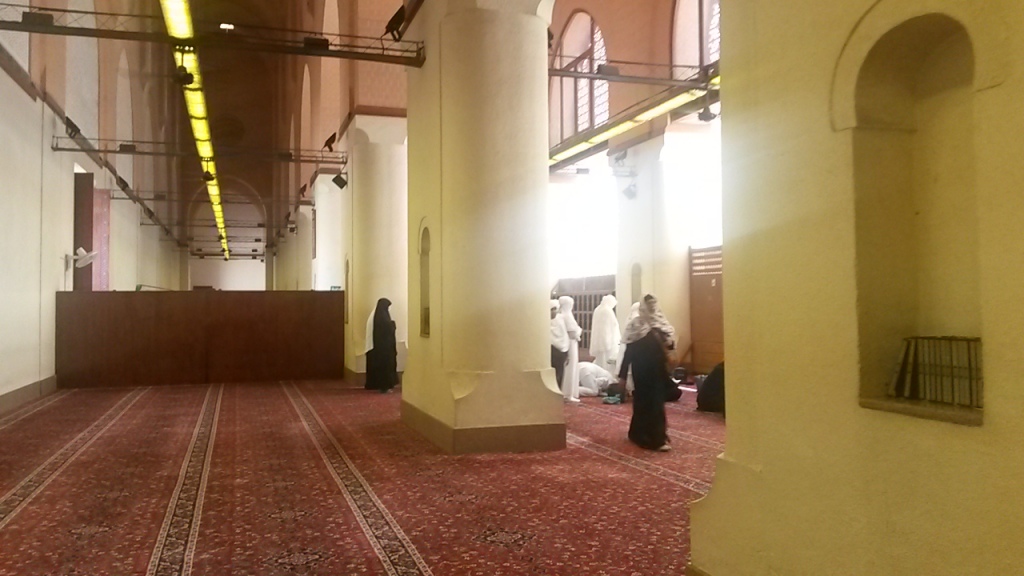Dear readers, Assalamu alaikum warahmatullah (peace be with you and God’s blessing)
Alhamdulillah (=thanks and praise to God), I am safely returned to Vancouver after successfully having performed all the rituals of Hajj. I pray my Hajj is accepted and that of all the hujjaj (=pilgrims). I pray also that all who lost their lives in the tragic accidents and events of this Hajj are elevated by it to ‘shuhada’ (=literally those who witness, often translated as martyrs, meaning those who are elevated to a very close state in/with the Divine presence, certainly their place in heaven assured), and I pray for strength, forbearance and fortitude for their families and friends.
Though none in our group was affected, we had a tent-mate from a different group who lost a relative that day…so the tragedy was brought close. Also close due to proximity and the near misses we ourselves had. But I will leave talking about this for later…the Hajj is such a once-in-a-lifetime experience, with so much it teaches, so much you learn about yourself and about people, about humanity and human nature, about the Divine presence and about life, that it is hard to find any words to synthesize one’s thoughts and emotions accurately. Therefore I thought to try to write a series of shorter articles, that each focus on a ritual or aspect of the Hajj and this way try to communicate some of what this journey is about, to my dear readers.
I will begin with the ‘Ihram’ (=pilgrim state, meaning both the dress and the demeanour a pilgrim must enter into in order to perform the Hajj. the word comes from the root word – ‘harama’, which carries the meaning of sanctuary. The grand mosque in Makkah is called the ‘haram’ meaning sanctuary, and in the way of life that is Islam, all things forbidden to a practitioner are called ‘haraam’ which though often translated to mean ‘forbidden’ actually means something more akin to ‘protection’). Ihram for men is that they wear two white untailored pieces of cloth and nothing else. Ihram for women is that they wear clothes that cover their ‘awrah’ (all except the face and hands, interestingly in the Hajj, women who wear a face-veil are required to remove it), and that it be un-figure revealing and in sombre shades, preferably white. Ihram for both includes, that hair and nails cannot be cut in that state, no perfume or any sort can be used, and that any act of intimacy is disallowed. Finally once in the Ihram state, one is not allowed to harm anything – one cannot pluck a leaf from a tree, nor step on an insect, and therefore of course, one is not allowed to harm another human being in any way or form – no pushing, shoving, no yelling, loosing one’s temper etc. One is also encouraged not to talk about worldly things…so the pilgrim focuses their thoughts and speech on being in dhikr (=remembrance, remembering God, being conscious of the Divine presence at all times), reciting Quran, contemplation, sending blessings upon the blessed beloved messenger of God, Muhammed (peace be upon him) while in Ihram.
The dress, the state one enters, the sacred places one is in, and unchanged rituals practiced since the time the prophet Abraham (peace be upon him) instituted the Hajj, and the fact that one is doing this in unison with millions of other human beings from all around the world and all walks of life, combine to make it a powerful state where one is helped abundantly to go ‘into ihram’. Others who have made the Hajj told me you forget everything else but where you are, what you are doing, and who you are going to, i.e., the final return to the Divine. I didn’t understand it, until I was in it. And it is true, no matter what is going on around one, you do forget everything else. Family, home, the work you left behind, all fade away and you feel a strong connection to humanity – a connection running through thousands of years, all the way to father Abraham (peace be upon him). You feel his greatness, his purity of worship of the One God, and the tremendousness of his faith. You are both crushed by it and elevated by it. You feel the strongest sense of gratitude to Abraham (in Arabic, ‘Ibraheem’, peace be upon him) and an immense sense of strength and guidance coming from him, through our beloved Muhammed (his heir and the final messenger, peace and blessing of God be upon him), and you feel that all of life has fallen into place. You feel the strongest connection to God, you feel the fragile nature of your own life, and the immensity of the Divine presence, and yet at the same time, you catch a glimpse of the greatness it is to be human and you are grateful and humbled by that.
Once in the ihram state, the pilgrims also constantly chant aloud ‘the talbiya’ – it too a chant that has not changed even by a syllable since the time of Muhammed (peace be upon him) who taught it to us. I don’t know if it was sung before then. It goes like this;
“labbayk, Allahumma labbayk
labbayka, la sharikalaka labbayk
inna al-hamda, wa al-ni’amtha,
laka wa al-Mulk. lasharikalak”
= ‘Here I am O God, here I am (answering your call)
Here I am, No partner do you have, Here I am
Verily, all praise belongs to You, verily, all good comes from You
And Your’s is the Dominion/Creation/Sovereignity/Ownership of all. No partner do You have’
We chant this non-stop through all the days and nights we are in Ihram, wherever we are. It is a very moving experience, when the chant begins, first in the plane, as all pilgrims chant it aloud once we pass over the ‘miqaat’ (=literally rondezvous point, it is the place where once you cross it, now you are in the pilgrim state), and then in the bus as we travel from one point to the other, then as we are walking, sometimes all of us seated in our tent, or you hear refrains from people sitting in solitary contemplation or walking alone. So I heard this call, and made it, from the bottom of my heart all those days I was in Ihram (about 8 or 9 totally) and I miss that state very much.
There are five ‘miqaat’ that Muhammed (peace be upon him) set out for us. 
They mark the points where pilgrims from all around the world are allowed to enter ‘Ihram. And they are positioned around the holy sights where the Hajj take place. When we first flew into the port city of Jeddah, (from where we took a bus to Makkah), our plane flew over the miqaat of ‘Yalamlam’ to the South of Makkah. The pilot makes an announcement that we are so many minutes away from the miqat, and once over it, we all make the intention out aloud that ‘O God, here I am to do the Hajj for You’ and then we have entered the state of ihram. We begin the talbiya then. It is awesome when the whole plane erupts into chanting talbiya! So we have done all the physical acts of Ihram (wearing the special clothes etc) before we board the plane, and we then ‘enter the state of ihram’ when we make this intention. Now, until we complete all the rights of Hajj, we are not allowed to remove the ihram.
In the way we did the Hajj, we entered into Ihram twice, first to perform the lesser pilgrimage, called ‘umrah’ and then on the 4th of dhul Hijja (Islamic 12th month of the year, Hajj takes place from 8th to 13th of dhul Hijja) to perform the Hajj. We entered into Ihram on the 4th of dhul Hijja from the miqaat north of Makkah, called Dhul Hulaifa. It is very close to the city of Madinah, where Muhammed (peace be upon him) spent the latter portion of his life. It is from this miqat that Muhammed (peace be upon him) entered his ihram when he performed his Hajj. So we were blessed to follow in his footsteps.
Dhul Hulaifa is about 450 km north of Makkah, and so the blessed prophet and his companions (God be pleased with them all) would have been in ihram a long time, as they went on foot from Madinah to Makkah. We traced the route, but traveling by bus. Nevertheless it was a beautiful feeling, to go along that same road. I was blessed to take the recommended shower before wearing the ihram, and then offer two units of voluntary ‘salat’ in the mosque of the prophet (peace be upon him), where he is now buried, in the city of Madinah, and then to go from their to Dhul Hulaifa where I ‘entered the state’ of Ihram. From this point onwards my Hajj had begun.
I will leave you with some pictures, inshaAllah more to follow in the days to come. It is now exactly two weeks since we left the tent city of Mina. Hard to believe, but glad I can finally begin to update this blog. Alhamdulillah!





Finally, here is a rendition of the talbiya I love, from an artist who is close to my heart – Dawud Wharnsby, a Canadian folk singer, very gifted. He captures the ‘feel’ of the talbiya in a very beautiful way. The way the talbiya is chanted at the start is how it is done during the Hajj. The group leader will begin, and we follow.
Enjoying reading this very much.
thx for sharing, as always.
LikeLiked by 1 person
Loved reading about your experience so far! Can’t wait to hear about the rest!
LikeLike
Masha Allah! Alhamdulillah you had a safe trip to and fro. Welcome back!:)
LikeLike